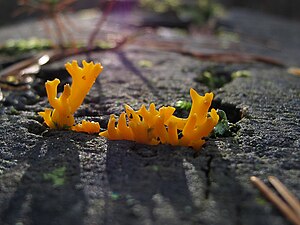Forked softwood horn
| Forked softwood horn | ||||||||||||
|---|---|---|---|---|---|---|---|---|---|---|---|---|

Forked Softwood Hornling ( Calocera furcata ) |
||||||||||||
| Systematics | ||||||||||||
|
||||||||||||
| Scientific name | ||||||||||||
| Calocera furcata | ||||||||||||
| ( Fr .: Fr. ) Fr. |
The Forked Softwood Hoernling ( Calocera furcata ) is a fungal art from the family of tears fungal relatives (Dacrymycetaceae). Like all horns ( Calocera ), it forms horn-like, tufted fruiting bodies that are yellow in color. The species is known from Japan and Europe and grows saprobion table on dead coniferous wood and causes brown rot there .
features
Macroscopic features
The fruiting bodies of the forked softwood horns are light yellow, horn-shaped and 10-20 × 1 mm in size. They often grow gregarious to tufted. Their surface is smooth or slightly wrinkled and sticky lengthways. They often take root deep in the substrate. They are sometimes slightly forked or branched at the top. They have an indistinct stalk, the rest of the fruiting body is covered with fertile hymenium .
Microscopic features
The hyphae structure of the species is monomitic , i.e. it consists only of generative hyphae. The innermost fruit body consists of a compact hyphae, surrounded by a looser structure, which in turn is covered by a compact hymenial layer. The spores are smooth and inamyloid and have three septa with thickened partitions. The latter is the only clear distinguishing feature from the awl-shaped hardwood hornling ( C. cornea ).
distribution
The forked softwood hornbill has been found in Japan and in various European countries. In Europe, the distribution extends from France to Finland.
ecology
The species is a saprobiont on dead conifers , in whose wood it causes brown rot by breaking down cellulose . The most common substrate is the silver fir ( Abies alba ), various pine trees ( Pinus spp.), Common juniper ( Juniperus communis ) and larches ( Larix decidua ) are also attacked. The forked softwood horns are mostly found in coniferous and mixed forests with a high proportion of coniferous trees .
swell
- German Josef Krieglsteiner (Ed.): The large mushrooms of Baden-Württemberg . Volume 1: General Part. Stand mushrooms: jelly, bark, prick and pore mushrooms. Ulmer, Stuttgart 2000, ISBN 3-8001-3528-0 .